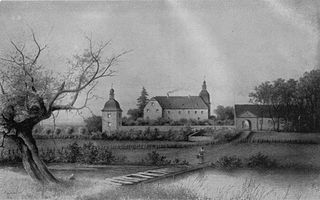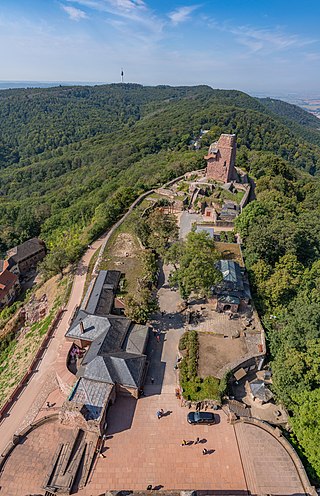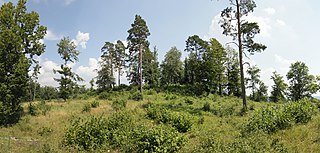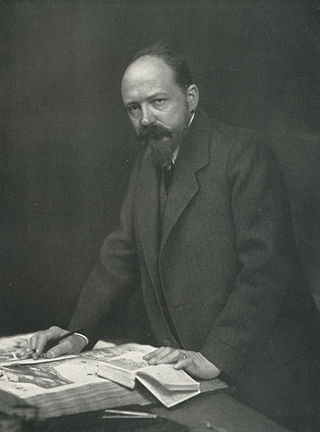Ludger Fischer (born 30 October 1957 in Essen) is a German historian on building history, reviewer of contemporary architecture and political scientist.
Contents

Ludger Fischer (born 30 October 1957 in Essen) is a German historian on building history, reviewer of contemporary architecture and political scientist.

In 1986 Fischer received his doctorate with a dissertation "Über den Denkmalwert sogenannter Zweckbauten" [On the historical value of so-called functional buildings]. [1] He published on castles at the Middle Rhine as Schönburg in Oberwesel and Rheinfels Castle in St. Goar. In his 2010 habilitation treatise Versuche baukünstlerischer Denkmalpflege [The attempts of artistic monument preservation] he examined the work of the architect Bodo Ebhardt (1865–1945). [2] Since 1995 Fischer focuses on contemporary building in the Netherlands and Belgium. He has been a member of the “advisory group on food store chains” of the European Commission, member of the Stakeholder Consultative Platform of the European Food Safety Authority EFSA and several other EU-panels on food safety. Based on his work as political consultant in Brussels he publishes books on the chemical and physical conditions of cooking. Fischer lives in Brussels.
Fischer's work on Bodo Ebhardt's architecture regarding historical castles received a positive review in the bulletin of the Baden-Württemberg state office for the preservation of monuments. [3] His books on the common errors of cooking practice were also well received by the German press including Frankfurter Rundschau , [4] Financial Times [5] and Hamburger Abendblatt . [6]
{{cite book}}: CS1 maint: location missing publisher (link)
Essen is the central and, after Dortmund, second-largest city of the Ruhr, the largest urban area in Germany. Its population of 579,432 makes it the fourth-largest city of North Rhine-Westphalia after Cologne, Düsseldorf and Dortmund, as well as the ninth-largest city of Germany. Essen lies in the larger Rhine-Ruhr Metropolitan Region and is part of the cultural area of Rhineland. Because of its central location in the Ruhr, Essen is often regarded as the Ruhr's "secret capital". Two rivers flow through the city: in the north, the Emscher, the Ruhr area's central river, and in the south, the Ruhr River, which is dammed in Essen to form the Lake Baldeney (Baldeneysee) and Lake Kettwig reservoirs. The central and northern boroughs of Essen historically belong to the Low German (Westphalian) language area, and the south of the city to the Low Franconian (Bergish) area.

Blankenstein Castle is a castle located on the south side of the river Ruhr in Hattingen, North Rhine-Westphalia, Germany.

Ludger was a missionary among the Frisians and Saxons, founder of Werden Abbey and the first Bishop of Münster in Westphalia. He has been called the "Apostle of Saxony".

Werden is a southern borough of the city of Essen in Germany. It belongs to the city district IX Werden/Kettwig/Bredeney and has 9,998 inhabitants as of June 30, 2006. The borough occupies a space of 4.04 km2 (1.56 sq mi) and is situated at a median height of 58 m above sea level (NN).

Styrum was an immediate lordship in the Holy Roman Empire, located in Mülheim an der Ruhr, North Rhine-Westphalia, Germany. It held no seat in the Diet and was circumvened by the Lordship of Broich.

Kettwig is the southernmost borough of the city of Essen in western Germany and, until 1975, was a town in its own right. Kettwig is situated next to the Ruhr river, at a median height of 53 metres above sea level. It is the most recently incorporated borough of Essen and also the largest in area, at 15.3 km². It belongs to the city district Stadtbezirk IX Werden/Kettwig/Bredeney and has 17,760 inhabitants as of June 2006.

Bladenhorst Castle is a moated castle in the suburbs of the city of Castrop-Rauxel.

Mickeln House is a manor house in Düsseldorf's Himmelgeist neighbourhood.

Otto Piper (1841–1921) was a German architectural historian who, with August von Cohausen (1812–1896), is regarded as one of the two founders of scientific research into castles.

The Imperial Castle of Kyffhausen is a medieval castle ruin, situated in the Kyffhäuser hills in the German state of Thuringia, close to its border with Saxony-Anhalt. Probably founded about 1000, it superseded the nearby imperial palace (Kaiserpfalz) of Tilleda under the rule of the Hohenstaufen emperors during the 12th and 13th centuries. Together with the Kyffhäuser Monument, erected on the castle grounds between 1890 and 1896, it is today a popular tourist destination. The castle is variously known in English as Kyffhausen Castle, Kyffhauser Castle, Kyffhäuser Castle, and Kyffhaueser Castle.

The ruins of the Thurant Castle stand on a wide slate hill spur above the villages of Alken on the Moselle in Germany. The castle is in the district of Mayen-Koblenz in Rhineland-Palatinate and belongs to the spur castle type. Vine gardens on the sunniest slope.
Gräfenberg Castle is the older of two former castles in Gräfenberg in the Upper Franconian county of Forchheim in the south German state of Bavaria. Today, there is little left of the castle; it is classed as a burgstall and the site is in the area of Bahnhofstraße 11 to 21. The castle was first recorded in the year 1477; its last remains were removed from about 1563.
Moschendorf Castle is a levelled mediaeval hill castle at a height of 400 m above sea level (NHN) about 50 metres east of the village of Moschendorf, in the market municipality of Gößweinstein in the Franconian county of Forchheim in the south German state of Bavaria.
Oberweilersbach Castle is a levelled mediaeval lowland castle in the northwest of the parish of Oberweilersbach, in the municipality of Weilersbach in the county of Forchheim in the south German state of Bavaria.

Ebermannstadt Castle is a levelled medieval motte castle on the heights of the Franconian Jura at Wacht Knock, west of the town of Ebermannstadt in the county of Forchheim in the south German state of Bavaria. It is one of the mightiest motte and bailey castles.
The burgstall of Unterailsfeld Castle is the site of a medieval lowland castle situated at a height of 360 m above sea level (NHN) in the village of Unterailsfeld, in the market municipality of Gößweinstein in the county of Forchheim in the south German state of Bavaria.
Hoger was the abbot of Werden and Saint Ludger in Helmstedt from 898 until 902.

Bodo Heinrich Justus Ebhardt was a German architect, architectural historian, castle explorer, and founder and longtime president of the German Castles Association.
Hartmut Hofrichter is a German architect, architecture historian, historic preservationist and academic teacher.

Maria Karoline Elisabeth Grollmuß was a Catholic Sorbian publicist and a socialist resistance member against the Nazi government.